
Home lifts are no longer a rare luxury in Kenya — they’re becoming part of modern living. With Nairobi’s growing number of multi-storey maisonettes, Mombasa’s high-end coastal villas, and Kisumu’s expanding residential estates, more homeowners are discovering that a lift adds convenience, accessibility, and property value.
Whether you’re caring for elderly family members, future-proofing your home for mobility needs, or simply adding a touch of prestige, the right lift can transform your living space. But with so many brands available, how do you choose the best fit?
Don’t worry — we’ve done the research for you. Choosing the right lift isn’t just about price. In this guide, we highlight Kenya’s nine most notable home lift brands in 2025, sharing each brand’s backstory and comparing their strengths, technology, key advantages and disadvantages, plus their after-sales service. It all play a role in how well it will serve you for years to come.
Whether you’re looking for a luxurious experience for a high-end home or a space-saving solution for a smaller residence, this article offers valuable insights to guide your choice.
Now, let’s take a closer look at these outstanding home lift brands!
Recommended Brands
6 Brand Overview at a Glance
| Brand | Best For |
|---|---|
| Stiltz Lifts | Compact, home-specific, through-floor, no-pit designs lift, suitable for limited spaces |
| Nibav Home Lifts | Energy-efficient, no-shaft pneumatic lifts |
| Kleemann |
Hydraulic home lift that offers a wide range of design options |
| Jatah Lifts | High load capacity for large households |
| PV Lifts | Local customisation and fast service |
| Wintech | Cost-effective, locally adaptable solutions |
*For Volkslift and Besterlifts, we didn’t find a lot of information on their website, but they do offer home lift solutions.
*For the big names like KONE Elevator, Otis and Schindler Elevator their main portfolio focuses on building lifts rather than dedicated home lifts.
*For Arrow Lifts, they are recognized in the market, but they don’t have a direct presence in Kenya.
Home Lift Buying Guide
When choosing a right home lift for your home, it’s not only about the style — it’s about finding a model that fits your home, your lifestyle, your budget and most importantly it meets your family’s needs while providing long-term convenience and safety. Below are the key considerations to help you make the smartest choice:
1. Budget: Premium vs. Value-for-Money Options
-
Premium brands – Nibav Home Lifts and Kleemann cater to homeowners looking for refined design, advanced engineering, and superior ride comfort. They often come with sleek interiors, cutting-edge safety systems, and long lifespans — but with higher purchase prices and servicing costs.
-
Value-for-money brands – Stiltz Lifts and Wintech provide functional, reliable lifts at more accessible price points. Stiltz shine in compact retrofits, while Wintech offers larger traction-based cabins for families wanting space without ultra-premium costs.
-
Mid-range local brands – PV Lifts and Jatah Lifts balance strong features with competitive pricing. Both are Kenyan-rooted, meaning faster service response and lower ongoing costs compared to fully imported brands.
Tip: Always factor in ongoing servicing costs alongside the purchase price. A cheaper lift with high maintenance costs may not save you money in the long run.
2. Home Structure: Renovation Needs & Space Requirements
-
Compact, no-pit designs – Stiltz Lifts and Nibav Home Lifts are perfect for Nairobi maisonettes or Mombasa holiday homes where space is tight. They can be installed without a lift pit or machine room, reducing structural changes.
-
Standard shaft lifts – Kleemann typically require a dedicated shaft and more building work, which suits new builds or major renovations. Their designs integrate smoothly into high-end villas and multi-level estates.
-
Custom-fit flexibility – PV Lifts and Nibav Home Lifts can adapt to various floor heights and layouts, suitable for upgrading older townhouses or villas.
Tip: Always request a site survey to confirm what’s structurally feasible before you commit.
3. Features: Accessibility, Quiet Operation, Energy Efficiency
-
Accessibility – Stiltz, Nibav, and PV Lifts all offer wheelchair-friendly models or step-free entry, making them excellent for elderly-friendly homes or multi-generational households.
-
Quiet operation – Stiltz, and Kleemann are known for smooth, low-noise travel — a big plus in multi-storey family homes.
-
Energy efficiency – Nibav and PV Lifts stand out with eco-friendly drive systems. Stiltz also has a low-energy motor, while Wintech’s traction systems consume more power but support larger cabins.
-
Smart controls – Kleemann offer integration with home automation systems for tech-savvy households who want app-based control and remote monitoring.
Tip: Match features to your actual needs — don’t overspend on luxury add-ons if you only need basic mobility.
4. After-Sales Service: Maintenance Network & Costs
-
Fast-response local support – PV Lifts and Jatah Lifts lead here. Being Kenyan-owned, they offer in-country engineers, local parts, and quick response times, reducing downtime.
-
Established global brands – Stiltz, Nibav, and Wintech all have Kenyan distributors who stock common parts, but major components may still need to be imported.
-
Flexible warranty packages – PV Lifts and Stiltz often offer extended service plans, which can be attractive for long-term peace of mind.
Tip: Choose a brand with proven reliability in Kenya and make sure the maintenance costs fit your budget. You can also check people’s reviews to see real customer experiences, and discuss your options thoroughly before deciding which home lift brand to choose.
6 Recommended Home Lift Brands – A Detailed Guide
When it comes to choosing a home lift, every household has different needs and budgets. Some homeowners prioritise the stability and luxury design of premium brands, while others look for the best value within a limited budget. For homes with space constraints or requiring customised solutions, flexibility and innovative design often become the deciding factors.
That’s why we’ve outlined the key advantages and disadvantages of each brand—so you can clearly see which option best fits your lifestyle and make a choice based on what truly matters to you.
Stiltz Home Lifts
Backstory:
Founded in the UK in 2010, Stiltz has gradually expanded worldwide and now sells with over 25,000 home lifts installed in 50 countries worldwide. We (Stiltz) created the shaftless through-floor lift concept to make home mobility upgrades easier, especially for ageing-in-place renovations. Designed specifically for modern homes, Stiltz home lifts stand out for their innovative features—no pit required, space-saving design, and quick installation—and in 2020, the brand was honoured with the Queen’s Award for Enterprise. [ Stiltz Home Lifts – About us ]
Strengths & Technology:
-
Self-supporting design, no pit or shaft required.
-
Compact footprint: fits into corners or unused spaces (eg., in a corner of a room, a stairwell void, or even a cupboard space).
-
Available in wheelchair-accessible Trio model.
-
Powered by a quiet, self-contained motor with low energy consumption.
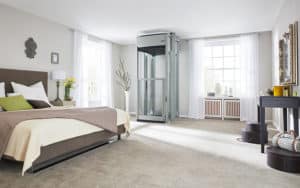
Advantages:
-
Compact footprint (0.55 m² – 1.25 m²), minimal construction work — no pit, shaft, or machine room required.
-
Quiet (≈50 dB) and smooth operation, suitable for residential use.
-
Quick installation, often completed in just a few days (1-2 days).
- Multiple safety features (equipped with a battery backup system, ensuring that even during a power cut, the cabin will safely return to the ground floor, obstruction detection system, automatic braking system and emergency stop button).
- Energy-efficient (similar to common household appliances, such as a microwave or kettle).
- Ideal for retrofits, private homes, townhouses, apartments, and even small commercial spaces (fits easily into corners, closets, or through existing floors).
Disadvantages:
-
Relatively low weight capacity (170 kg – 220 kg), which may limit its suitability for transporting bulky items.
-
Limited travel height, typically up to 2–3 floors, so less suitable for taller homes.
- More of a mobility and convenience lift than a heavy-duty transport solution.
-
Smaller cabin size.
Model:
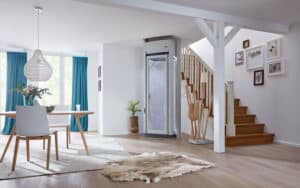
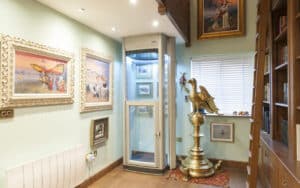
Duo+ Home Lift (1-2 people) and Trio+ Home Lift (fits one wheelchair user plus a caregiver or 3 people)
After-Sales Service in Kenya:
Serviced by our Kenyan distributor, with essential parts stocked locally and larger components sourced from the UK. Our friendly, professional team is always ready to help—whether it’s a quick fix or a bigger job, we’ve got you covered.
Nibav Lifts
Backstory:
Since its founding in 2019, Nibav Home Lifts has grown into a leading name in the home elevator market, operating in over 12 countries with more than 40 experience centers worldwide. Nibav set out to make pneumatic vacuum lifts affordable for modern homes. The brand quickly gained traction in Africa, the Middle East, and Asia for its compact, stylish designs. [ Nibav Lifts – About us ]
Strengths & Technology:
-
Pneumatic vacuum technology — no shaft, no pit, minimal civil works.
-
Uses power only to go up; gravity for descent.
-
Transparent cabin design fits modern interiors.

Advantages:
-
Space-saving, fast installation (4-5 days).
-
Very energy efficient.
-
Sleek, modern appearance.
Disadvantages:
-
Small cabin size (Although the website does not specifically state the passenger capacity, based on the weight limit, we can assume it accommodates up to three people or one wheelchair user.)
-
Limited load capacity (210 kg – 240 kg), making it less suitable for bulky items.
-
Higher cost than basic hydraulic models.
Model:


Series III Standard, Series III Max, Series IV Standard and Series IV Max
After-Sales Service in Kenya:
Serviced by authorised Nairobi dealer. Local spare parts stocked; technicians trained on pneumatic systems. Annual maintenance contracts available.
PV Lifts
Backstory:
A Kenyan-owned company with over ten years of experience in vertical transport, PV Lifts started in the commercial space before moving into homes. Offering both locally built hydraulic and traction lifts as well as imported pneumatic vacuum models like the PVE 30, 37, and 52. [ PV Lifts – About us ]
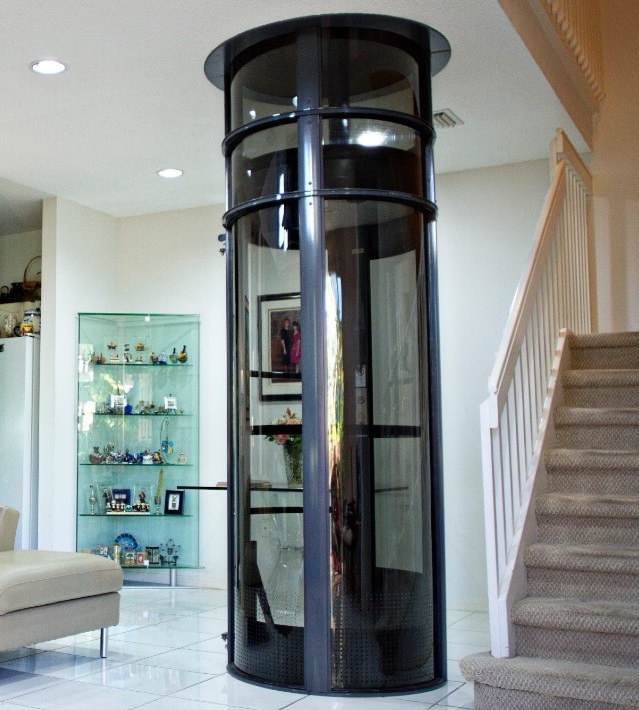
Strengths & Technology:
-
Offers both hydraulic and traction systems.
-
Custom-built for space, budget, and design needs.
-
Strong local market knowledge.
Advantages:
-
Fully local support and service.
-
Energy efficient (gravity descent).
-
Quick installation (2-3 days).
Disadvantages:
-
Fewer luxury styling options.
- Limited load capacity (350 lbs – 450 lbs – 525 lbs) compared to hydraulic/traction lifts.
-
Hydraulic systems use more power than traction.
Model:


After-Sales Service in Kenya:
Nationwide service team; local assembly ensures easy part replacement. Fast turnaround for breakdowns.
Jatah Lifts
Backstory:
Kenyan-owned company that first specialised in large-capacity commercial lifts before offering residential models designed for multi-generational homes. [Jatah Lifts – About Us ]

Strengths & Technology:
-
Offers compact traction and hydraulic home lifts designed to fit seamlessly into living areas.
-
Stylish interiors and finishes suited to contemporary Kenyan homes.
Advantages:
-
Compact design ideal for homes with limited space.
-
Locally installed and supported — no need for complicated imports.
-
Modern look that integrates into stylish interiors (as shown on their site).
Disadvantages:
-
Limited public technical specifications available online (capacity, speed, etc.).
- Not as globally recognised as international brands like Nibav or Stiltz.
- The company does not publish official capacity details for its home lifts. However, since they are marketed as compact home lifts, it’s safe to assume the cabin is smaller and may be less suitable for comfortably carrying multiple passengers at once.

* That said, we found a Facebook post stating:
“From offloading to a fully installed luxurious home lift! This 800 kg capacity lift serves 3 floors, featuring a gold finish for a touch of elegance.”
This suggests that while Jatah promotes compact home lifts, they also have the ability to deliver larger-capacity residential models (up to 800 kg).
After-Sales Service in Kenya:
Fully Kenyan-based service team, meaning faster response times than international-only suppliers.
Kleemann
Backstory:
Founded in Greece in 1983, Kleemann is known for luxury lift interiors and working closely with architects on high-end projects. Over the years, Kleemann has grown into one of Europe’s preeminent elevator manufacturers, producing up to 12,000 complete lift systems annually. [ Kleemann – About us ]

Strengths & Technology:
-
High-end European styling.
-
Panoramic glass options.
-
Smooth, quiet operation.
Advantages:
-
Wide choice of customisable cabin designs, including panoramic and architectural lift models.
- Kleemann’s Maison range stands out by offering more stops (5–6) than most compact home lift competitors.
Disadvantages:
-
Premium price point—custom solutions and European-quality come at a higher cost.
-
Long lead times for bespoke models, particularly for highly customised cabins or finishes.
-
Structural complexity may be greater than simpler solutions — especially for panoramic or bespoke installations, which often require careful architectural integration and therefore take more time to plan and install.
Model:


Maison200 H , Maison100 H , Maison100 E and MasionLIFT Plus
After-Sales Service in Kenya:
Kleemann products are available through authorised distributors in Kenya, such as Elevation World Limited and ENG-CONS LTD
Wintech
Backstory:
Founded in Tanzania in 2001, Wintech is a growing East African elevator company with an expanding presence in both Tanzania and Kenya. With over 600 installations in Dar es Salaam and nearby regions, the brand has built strong regional credibility and market traction.

Strengths & Technology:
-
Focuses on spacious cabin design, possibly with wider dimensions to accommodate passengers and cargo comfortably.
-
Offers a range of traction-based elevators suited for both residential and commercial applications.
Advantages:
-
Regional experience & service footprint across East Africa—making them accessible for installations and support in Kenya.
-
Spacious cabin design may offer greater comfort than compact models in the home-lift segment.
-
Likely well-suited for multi-storey homes or small commercial settings that need a smoother ride and larger cabin.
Disadvantages:
-
No clear detail on max stops, load capacity, or specific home-oriented lift options on their Kenya site.
-
Not a compact solution: Wintech focuses on traction-based elevators with spacious cabins, meaning they typically require more structural space than pneumatic or through-floor designs.
-
Longer planning and installation: traction elevators generally need a shaft and pit, so the building must be prepared — unlike compact shaftless lifts that install in days.
- Less brand recognition: compared to global leaders (Stiltz, Nibav), Wintech is still a developing regional player, which may affect perceived prestige.
Model:
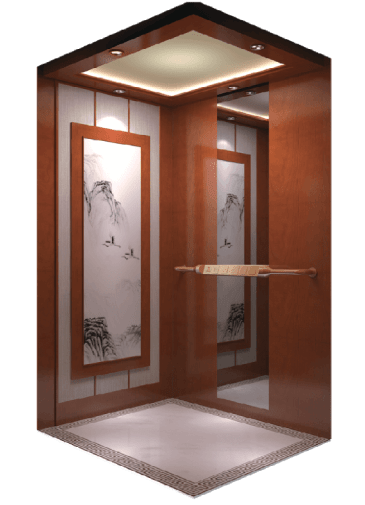
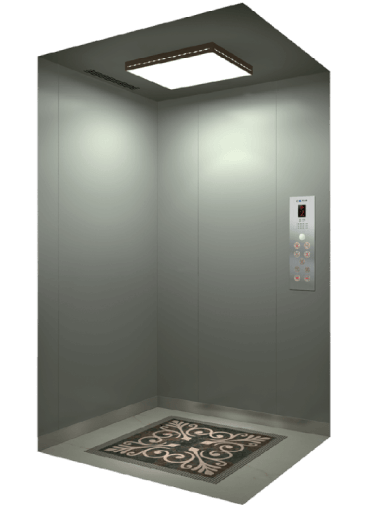
KL/J4-005 and KL/J4-006
After-Sales Service in Kenya:
As an East Africa-focused provider, Wintech is likely servicing installations across Kenya, especially in urban areas and larger estates.
Kenya Home Lift Comparison Chart
Stiltz Lifts
$$$ · upper mid-range
Ideal customer
Homeowners renovating or needing compact, easy-install mobility.
Features
- Self-supporting design; no pit/shaft
- Duo & Trio models
- Quiet motor; wheelchair option
Space
Very compact; fits in corners, landings, or voids.
Service (KE)
Kenyan agents; local install & servicing teams.
Nibav Home Lifts
$$$ · upper mid-range
Ideal customer
Modern homeowners wanting stylish, energy-efficient lifts with minimal construction.
Features
- Transparent cylindrical cabin
- Energy-saving gravity descent
- Quick 2–3 day installation
Space
Compact footprint; no shaft or pit required.
Service (KE)
Nairobi showroom; authorised dealer; local spare parts.
Kleemann
$$$$ · premium
Ideal customer
High-end builders & architects seeking bespoke design flexibility.
Features
- Maison 100/200 (5–6 stops)
- Customisable interiors
- Panoramic glass options
Space
Needs shaft; panoramic models require more space/structural input.
Service (KE)
Partner installers in Nairobi & Mombasa; custom parts imported.
Jatah Lifts
$$–$$$ · mid to upper
Ideal customer
Kenyan families needing reliable, spacious lifts with local servicing.
Features
- Compact home lift range
- Durable design
- Locally installed & supported
Space
Requires shaft; footprint larger than pneumatic/shaftless.
Service (KE)
Kenyan HQ with engineers; stocked parts; strong local servicing.
PV Lifts
$$ · mid-range
Ideal customer
Buyers wanting flexible options & strong local support.
Features
- Local hydraulic/traction builds
- PVE vacuum lifts up to 5 stops
- Tailored design solutions
Space
Hydraulic/traction need shaft; PVE models are shaftless & compact.
Service (KE)
Strong national network; local assembly; fast spare parts supply.
Wintech Elevators
$$–$$$ · mid to upper
Ideal customer
Homeowners wanting spacious cabins & comfortable movement between floors.
Features
- Spacious cabin focus
- Traction drive, robust design
- Home & light commercial suitable
Space
Requires shaft & pit; less compact than pneumatic/through-floor.
Service (KE)
Nairobi presence; regional support across East Africa.
While we couldn’t source official Kenya-specific pricing, UK market data gives a useful benchmark of how these brands are positioned. ( These tiers are based on UK benchmarks. Kenyan prices will vary due to import duties, shipping, and local installation/service contracts, but the relative positioning (value vs. mid-range vs. premium) generally remains the same.
Value Tier (approx. £10,000–£20,000)
-
Stiltz Lifts → £12,000–£20,000 (compact, affordable through-floor option)
Mid-Range Tier (approx. £23,000–£30,000)
-
Wintech Elevators → £23,000–£28,000 (custom hydraulic options up to £50,000)
-
PV Lifts → £26,000–£28,000 (hydraulic and traction systems, flexible designs
Premium Tier (above £30,000)
-
Nibav Home Lifts → £41,000–£78,000 (pneumatic vacuum, luxury finishes, imported)
-
Kleemann → Typically higher than mid-range due to customisation and multi-floor capability.
Note: We’ve used UK price ranges as a reference point. Actual costs in Kenya will definitely differ due to shipping, duties, and local installation. Treat these figures only as a rough guide — not exact prices.
Quick Takeaways – Who Should Choose What
-
If you want quick, space-saving installs: Stiltz, Nibav (shaftless or pneumatic compact lifts, ideal for retrofits and homes with limited space).
-
If local service is your #1 priority: PV Lifts, Jatah, Wintech (Kenyan-based companies with local assembly, stocked parts, and strong technician networks).
-
If you want luxury feel and prestige: Nibav, Kleemann (premium brands with smooth rides, custom interiors, and architectural flexibility).
-
If you want practical comfort and good value without going ultra-premium: Stiltz, Kleemann (Kleemann offers spacious cabins and customisable interiors, while Stiltz offers compact shaftless convenience).
-
If you need to move more people or heavy loads: Jatah, Kleemann (Jatah with locally installed larger traction lifts, Kleemann with Maison models serving 5–6 floors).
Compact Home Lifts in Kenya: Comparison Chart
Stiltz Home Lifts
2–3 floors
Duo (2 passengers), Trio (wheelchair)
Very compact — fits in corners/small spaces
1–2 days
- No shaft/pit needed
- Fits almost anywhere
- Quick installation
- Wheelchair model available
- Limited to 2–3 floors
- Compact cabin
- Not for heavy loads
Local distributor support; parts imported from UK
Nibav Lifts
2–4 floors
Small cylindrical cabins: ~2–3 passengers
Compact transparent cylinder
4-5 days
- Very energy-efficient (gravity descent)
- Sleek, modern look
- Transparent cabin aesthetic
- Cylindrical shape limits usable space
- Not for heavy loads
- Often pricier than hydraulics
Nairobi showroom & dealer; local parts stocked
PV – PVE Models (30 / 37 / 52)
Up to 5 (model-dependent)
PVE 30 (1 pax), PVE 37 (2 pax / wheelchair), PVE 52 (3 pax / wheelchair + attendant)
PVE 30 smallest footprint; PVE 52 requires more space
2–3 days
- Serves up to 5 floors
- Multiple cabin sizes
- Wheelchair accessible
- Larger models need more space
- Round cabin may not suit all interiors
- Premium price
Distributed & serviced by PV Lifts; local parts, larger components imported
» Quick Takeaways
-
Stiltz → Best for homes with very tight spaces or quick retrofits.
-
Nibav → Best for those wanting sleek design + energy efficiency.
-
PVE models → Best for taller homes (up to 5 stops) or families needing larger cabin options.
How to Choose the Right Home Lift in Kenya
Step 1 — Clarify why you need it (and who will use it)
-
List your must-haves: wheelchair access? kids/elderly use? heavy groceries/water bottles?
-
Note floors to serve and preferred door direction (same-side or opposite).
-
Step 2 — Do a quick space & power check
-
Measure the spot you have in mind (width × depth × height) and the floor opening available.
-
Can you host a shaft or pit? If not, shortlist shaftless/through-floor or pneumatic options.
-
Power reality: do you have stable 240V? If outages are common, ask for battery/manual lowering and compatibility with your inverter/generator.
Step 3 — Pick a lift type that fits your home
-
Shaftless/through-floor (compact pods): minimal building work, great for tight spaces.
-
Machine-room-less traction (MRL): smooth, energy-efficient, needs a small shaft.
-
Hydraulic: strong lift capacity, slightly higher service needs, needs a small pit/shaft.
(If you’re between brands like Stiltz, Nibav, PV Lifts, Kleemann, etc., this step helps you narrow the type first, then the brand.)
Step 4 — Shortlist brands that can actually support your county
-
Ask each vendor: “Do you have technicians in my county? How many? What is typical response time?”
-
Check there’s a local parts stock so you’re not waiting weeks.
Step 5 — Get different brands’ quotes
Request each quote to include:
-
Model & drive type, capacity (kg) and persons, stops/floors, door style, speed.
-
Building works included/not included (civil works, cutting, making good).
-
Safety features (battery lowering, interlocks, emergency phone).
-
Warranty length, what it covers, and annual maintenance fee after year 1.
-
Delivery & installation timeline, and penalties if they slip.
Step 6 — Visit or see one working
-
Ask for a showroom visit or a recent installation in your area.
-
Ride it. Check noise, door smoothness, start/stop comfort, and safety feature.
-
Talk to the homeowner about real-world service experience, or check online forums and Google reviews to see what other customers are saying.
Step 7 — Check standards & safety basics
-
Ask for compliance with relevant safety standards (e.g., KS/ISO 8100 series), and request the test certificate/handover checklist.
-
Confirm emergency lowering during power cuts and that users get a simple rescue guide.
Step 8 — Look beyond just the lift price
-
Add up: purchase + delivery + civil works + first-year service + years 2–5 service.
-
Ask about typical spare-part prices (doors, rollers, batteries) and recommended service intervals.
-
Prefer energy-efficient models if usage will be daily (it pays back on power bills).
Step 9 — Plan the site works (so install is smooth)
-
Agree who handles civil works (builder vs. lift company).
-
Lock down dates for cutting openings, electrical, and final finishing.
-
Check if your estate/management needs approvals for works and deliveries.
Step 10 — Sign with protection
-
Ensure your contract lists: exact spec, total price, payment milestones, warranty terms, maintenance plan, response times, and training at handover.
Before getting a home lift, check out our article “25 Common Home Lift Installation Mistakes” so you can avoid them before you buy.
It covers planning and permits, construction, lifestyle and insurance, space and daily use, safety, industry insights, current home lift market trends, myths vs. facts (including debunking common misconceptions people have about lifts), and a readiness checklist—everything you need to choose wisely and prevent costly errors.
Summary
Every home lift brand has something different to offer—whether you love stylish luxury, need something practical, or want the latest smart features, there’s a lift out there for you. When you’re choosing, keep these key things in mind:
-
Home structure: Will you need to remodel or reinforce any space?
-
Personal needs: Do you prioritise energy efficiency, quiet operation, custom design, or smart features?
-
Budget range: Pick a brand that fits your finances and has reasonable long-term maintenance costs.
Local Advice for Kenya:
In Kenya, it’s especially important to:
-
Check after-sales coverage—ensure technicians can reach you quickly and spare parts are stocked locally.
-
Plan for power cuts by choosing models with battery backup, manual lowering, or compatibility with inverters/generators.
-
Factor in approvals if you live in an estate or gated community—some managements require permits before structural works.
-
Ask for references from recent Kenyan customers to confirm service quality and reliability in local conditions.
Choosing the right home lift can make daily life easier, safer, and more comfortable for you and your family. Take some time to look at your needs, your home’s layout, and the brands we’ve covered to find the one that truly fits you best. With the right planning, your lift can run smoothly for many years—even with Kenya’s unique building styles and power challenges.
We hope this guide has helped clear up what to look for when picking a home lift. If one of the brands or models caught your eye, why not reach out to a local dealer and see it in action? With the right choice, your home lift won’t just move you between floors—it’ll be a trusted part of your everyday life.
FAQ
Is a pitless lift suitable for all homes?
Pitless lifts, with their no-deep-excavation design, are ideal for existing buildings or homes where major structural alterations aren’t possible—especially in spaces like villas, apartments, or older houses undergoing renovation. They’re a great fit for properties with limited space.
However, they aren’t suitable for every home. The building’s floor slabs may need extra reinforcement to safely support the lift’s weight. In addition, if the height between floors is too low, this can limit the lift’s installation options or design choices.
Therefore, when considering a pitless lift, it’s essential to have a professional engineer assess your home’s structure and needs to ensure it’s truly suitable and will deliver the best results.
How to Choose the Best Home Lift?
Choosing the best home lift means weighing several important factors:
-
Check your space and design fit – Make sure the lift design matches your home’s existing structure. If space is tight, a pitless design can save valuable room.
-
Prioritise safety features – Look for essentials like emergency lowering during power cuts and secure door interlocks to keep your family safe.
-
Consider installation difficulty and time – Go for a model that installs quickly and with minimal disruption to your building.
-
Assess energy use and noise levels – Choose an energy-efficient lift that won’t push up your bills and operates quietly to keep your home peaceful.
-
Choose a reputable brand – Pick one with a solid track record, strong after-sales service, and good user reviews.
For Kenya specifically, also confirm local service availability, ensure spare parts are stocked nearby, and check compatibility with your power backup system so the lift remains reliable even during outages.
How often should a home lift be serviced, and what does it involve?
Do home lifts consume a lot of electricity?
Home lifts generally use very little electricity and won’t cause a big jump in your power bill, making them an economical choice. On average, a home lift’s running power is about 1 to 3 kilowatts—similar to a microwave or air conditioner—but because each trip only lasts a short time, the actual energy use is quite low.
When idle, power consumption is minimal, and many energy-efficient models have an automatic low-power standby mode to save even more electricity.



